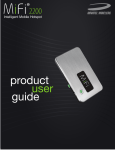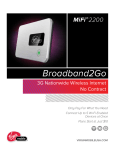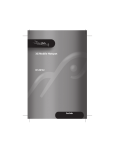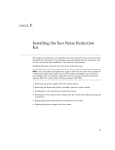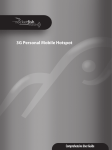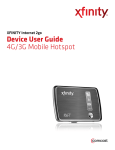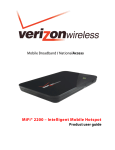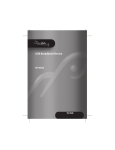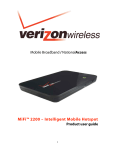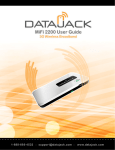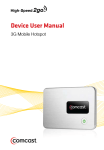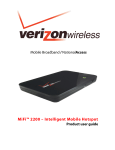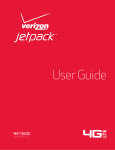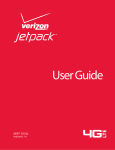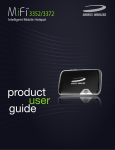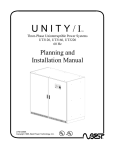Download Supplemental User Guide
Transcript
Supplemental User Guide ©2010 Comcast. All rights reserved. The information contained in this document is subject to change without notice and should not be construed as a commitment by Comcast. Patents and Licenses Visit www.novatelwireless.com/patents for a complete list of all Novatel Wireless patents. Software License Proprietary Rights Provisions: The software drivers provided with this product are copyrighted by Novatel Wireless and/or Novatel Wireless’ suppliers. Although copyrighted, the software drivers are unpublished and embody valuable trade secrets proprietary to Novatel Wireless and/or Novatel Wireless’ suppliers. The disassembly, decompilation, and/or Reverse Engineering of the software drivers for any purpose is strictly prohibited by international law. The copying of the software drivers, except for a reasonable number of back-up copies is strictly prohibited by international law. It is forbidden by international law to provide access to the software drivers to any person for any purpose other than processing the internal data for the intended use of the software drivers. U.S. Government Restricted Rights Clause: The software drivers are classified as “Commercial Computing device Software” and the U.S. Government is acquiring only “Restricted Rights” in the software drivers and their Documentation. U.S. Government Export Administration Act Compliance Clause: It is forbidden by US law to export, license or otherwise transfer the software drivers or Derivative Works to any country where such transfer is prohibited by the United States Export Administration Act, or any successor legislation, or in violation of the laws of any other country. Trademarks and Service Marks Comcast, the Comcast logo, and High-Speed 2go are trademarks of Comcast. Novatel Wireless is a trademark of Novatel Wireless, Inc., and the other trademarks, logos, and service marks (collectively the “Trademarks”) used in this user manual are the property of Novatel Wireless or their respective owners. Nothing contained in this user manual should be construed as granting by implication, estoppel, or otherwise, a license or right of use of Novatel Wireless or any other Trademark displayed in this user manual without the written permission of Novatel Wireless or its respective owners. • MobiLink™, Novatel Wireless™, and the Novatel Wireless logo™ are all trademarks of Novatel Wireless, Inc. • MiFi® and the MiFi logo® are registered trademarks of Novatel Wireless, Inc. • Microsoft and Windows® are either registered trademarks or trademarks of Microsoft Corporation in the United States and/ or other countries. • Apple®, Mac®, and Mac OS® are trademarks of Apple, Inc., registered in the U.S. and other countries. • Linux® is the registered trademark of Linus Torvalds in the U.S. and other countries. The names of actual companies and products mentioned in this user manual may be the trademarks of their respective owners. FCC ID: PKRNVWMiFi2200 PN: 90026300 R1 27Oct2010 Please visit http://customer.comcast.com/2go for the latest information about your device. Contents Product Overview. . . . . . . . . . . . . . . . . . . . . . . . . . . . . . . . . . . . . . . . . . . . . . . . . . . . . . . . 1 3G Mobile Hotspot Overview . . . . . . . . . . . . . . . . . . . . . . . . . . . . . . . . . . . . . . . . . . . . . . . . . . . . . . . . . . . . . . . . . Features. . . . . . . . . . . . . . . . . . . . . . . . . . . . . . . . . . . . . . . . . . . . . . . . . . . . . . . . . . . . . . . . . . . . . . . . . . . . . . . . . . Package Contents . . . . . . . . . . . . . . . . . . . . . . . . . . . . . . . . . . . . . . . . . . . . . . . . . . . . . . . . . . . . . . . . . . . . . . . . System Requirements. . . . . . . . . . . . . . . . . . . . . . . . . . . . . . . . . . . . . . . . . . . . . . . . . . . . . . . . . . . . . . . . . . . . Your 3G Mobile Hotspot . . . . . . . . . . . . . . . . . . . . . . . . . . . . . . . . . . . . . . . . . . . . . . . . . . . . . . . . . . . . . . . . . . . . . . LED Operation. . . . . . . . . . . . . . . . . . . . . . . . . . . . . . . . . . . . . . . . . . . . . . . . . . . . . . . . . . . . . . . . . . . . . . . . . . . Caring for Your Device. . . . . . . . . . . . . . . . . . . . . . . . . . . . . . . . . . . . . . . . . . . . . . . . . . . . . . . . . . . . . . . . . . . . Power Management. . . . . . . . . . . . . . . . . . . . . . . . . . . . . . . . . . . . . . . . . . . . . . . . . . . . . . . . . . . . . . . . . . . . . . . . . . Battery Tips. . . . . . . . . . . . . . . . . . . . . . . . . . . . . . . . . . . . . . . . . . . . . . . . . . . . . . . . . . . . . . . . . . . . . . . . . . . . . . 2 2 3 3 4 5 6 6 7 Using Your 3G Mobile Hotspot. . . . . . . . . . . . . . . . . . . . . . . . . . . . . . . . . . . . . . . . . . . . 8 Using Your 3G Mobile Hotspot for the First Time. . . . . . . . . . . . . . . . . . . . . . . . . . . . . . . . . . . . . . . . . . . . . . . 9 Inserting and Charging the Battery . . . . . . . . . . . . . . . . . . . . . . . . . . . . . . . . . . . . . . . . . . . . . . . . . . . . . . . 9 Connecting to Your Mobile Hotspot. . . . . . . . . . . . . . . . . . . . . . . . . . . . . . . . . . . . . . . . . . . . . . . . . . . . . . . . . . 11 Personalize and Change Your 3G Mobile Hotspot Settings. . . . . . . . . . . . . . . . . . . . . . . . . . . . . . . . . 11 Personalize the Administrative Password. . . . . . . . . . . . . . . . . . . . . . . . . . . . . . . . . . . . . . . . . . . . . 12 Personalize the Network Name (SSID) . . . . . . . . . . . . . . . . . . . . . . . . . . . . . . . . . . . . . . . . . . . . . . . . 12 Personalize Your Network Key (i.e., WiFi Key, Security Key, WPA Password) . . . . . . . . . . . . . 12 3G Mobile Hotspot Settings . . . . . . . . . . . . . . . . . . . . . . . . . . . . . . . . . . . . . . . . . . . . . 13 3G Mobile Hotspot Settings Basics . . . . . . . . . . . . . . . . . . . . . . . . . . . . . . . . . . . . . . . . . . . . . . . . . . . . . . . . . . . Open the 3G Mobile Hotspot Settings . . . . . . . . . . . . . . . . . . . . . . . . . . . . . . . . . . . . . . . . . . . . . . . . . . . The Home Page . . . . . . . . . . . . . . . . . . . . . . . . . . . . . . . . . . . . . . . . . . . . . . . . . . . . . . . . . . . . . . . . . . . . . . . . . . . . . The Menu Bar . . . . . . . . . . . . . . . . . . . . . . . . . . . . . . . . . . . . . . . . . . . . . . . . . . . . . . . . . . . . . . . . . . . . . . . . . . . Home Page Sections. . . . . . . . . . . . . . . . . . . . . . . . . . . . . . . . . . . . . . . . . . . . . . . . . . . . . . . . . . . . . . . . . . . . . Internet Connection. . . . . . . . . . . . . . . . . . . . . . . . . . . . . . . . . . . . . . . . . . . . . . . . . . . . . . . . . . . . . . . . . WiFi. . . . . . . . . . . . . . . . . . . . . . . . . . . . . . . . . . . . . . . . . . . . . . . . . . . . . . . . . . . . . . . . . . . . . . . . . . . . . . . . . Password. . . . . . . . . . . . . . . . . . . . . . . . . . . . . . . . . . . . . . . . . . . . . . . . . . . . . . . . . . . . . . . . . . . . . . . . . . . . . . . . . . . Create a New Administrative Password . . . . . . . . . . . . . . . . . . . . . . . . . . . . . . . . . . . . . . . . . . . . . . . . . . WiFi Menu. . . . . . . . . . . . . . . . . . . . . . . . . . . . . . . . . . . . . . . . . . . . . . . . . . . . . . . . . . . . . . . . . . . . . . . . . . . . . . . . . . WiFi Profiles. . . . . . . . . . . . . . . . . . . . . . . . . . . . . . . . . . . . . . . . . . . . . . . . . . . . . . . . . . . . . . . . . . . . . . . . . . . . . Choosing a Profile . . . . . . . . . . . . . . . . . . . . . . . . . . . . . . . . . . . . . . . . . . . . . . . . . . . . . . . . . . . . . . . . . . . Setting Security . . . . . . . . . . . . . . . . . . . . . . . . . . . . . . . . . . . . . . . . . . . . . . . . . . . . . . . . . . . . . . . . . . . . . MAC Filter. . . . . . . . . . . . . . . . . . . . . . . . . . . . . . . . . . . . . . . . . . . . . . . . . . . . . . . . . . . . . . . . . . . . . . . . . . . . . . . Finding the MAC Address. . . . . . . . . . . . . . . . . . . . . . . . . . . . . . . . . . . . . . . . . . . . . . . . . . . . . . . . . . . . Using MAC Filtering. . . . . . . . . . . . . . . . . . . . . . . . . . . . . . . . . . . . . . . . . . . . . . . . . . . . . . . . . . . . . . . . . Status. . . . . . . . . . . . . . . . . . . . . . . . . . . . . . . . . . . . . . . . . . . . . . . . . . . . . . . . . . . . . . . . . . . . . . . . . . . . . . . . . . . WiFi Clients . . . . . . . . . . . . . . . . . . . . . . . . . . . . . . . . . . . . . . . . . . . . . . . . . . . . . . . . . . . . . . . . . . . . . . . . . WiFi Log. . . . . . . . . . . . . . . . . . . . . . . . . . . . . . . . . . . . . . . . . . . . . . . . . . . . . . . . . . . . . . . . . . . . . . . . . . . . . WWAN Menu . . . . . . . . . . . . . . . . . . . . . . . . . . . . . . . . . . . . . . . . . . . . . . . . . . . . . . . . . . . . . . . . . . . . . . . . . . . . . . . Configuration . . . . . . . . . . . . . . . . . . . . . . . . . . . . . . . . . . . . . . . . . . . . . . . . . . . . . . . . . . . . . . . . . . . . . . . . . . . 14 14 15 15 16 16 17 18 18 19 20 21 21 22 22 23 23 24 24 25 25 Diagnostics. . . . . . . . . . . . . . . . . . . . . . . . . . . . . . . . . . . . . . . . . . . . . . . . . . . . . . . . . . . . . . . . . . . . . . . . . . . . . 26 WWAN Connection. . . . . . . . . . . . . . . . . . . . . . . . . . . . . . . . . . . . . . . . . . . . . . . . . . . . . . . . . . . . . . . . . . 27 WWAN Modem . . . . . . . . . . . . . . . . . . . . . . . . . . . . . . . . . . . . . . . . . . . . . . . . . . . . . . . . . . . . . . . . . . . . . 28 WWAN Event Log . . . . . . . . . . . . . . . . . . . . . . . . . . . . . . . . . . . . . . . . . . . . . . . . . . . . . . . . . . . . . . . . . . . 28 WWAN Status. . . . . . . . . . . . . . . . . . . . . . . . . . . . . . . . . . . . . . . . . . . . . . . . . . . . . . . . . . . . . . . . . . . . . . . . . . . 29 Internet Connection. . . . . . . . . . . . . . . . . . . . . . . . . . . . . . . . . . . . . . . . . . . . . . . . . . . . . . . . . . . . . . . . . 30 Traffic Counters. . . . . . . . . . . . . . . . . . . . . . . . . . . . . . . . . . . . . . . . . . . . . . . . . . . . . . . . . . . . . . . . . . . . . 30 Internet Connection Log. . . . . . . . . . . . . . . . . . . . . . . . . . . . . . . . . . . . . . . . . . . . . . . . . . . . . . . . . . . . . 31 Advanced Menu. . . . . . . . . . . . . . . . . . . . . . . . . . . . . . . . . . . . . . . . . . . . . . . . . . . . . . . . . . . . . . . . . . . . . . . . . . . . . 32 Advanced Settings. . . . . . . . . . . . . . . . . . . . . . . . . . . . . . . . . . . . . . . . . . . . . . . . . . . . . . . . . . . . . . . . . . . . . . 33 Access Point. . . . . . . . . . . . . . . . . . . . . . . . . . . . . . . . . . . . . . . . . . . . . . . . . . . . . . . . . . . . . . . . . . . . . . . . . 33 3G Modem. . . . . . . . . . . . . . . . . . . . . . . . . . . . . . . . . . . . . . . . . . . . . . . . . . . . . . . . . . . . . . . . . . . . . . . . . . 34 Router. . . . . . . . . . . . . . . . . . . . . . . . . . . . . . . . . . . . . . . . . . . . . . . . . . . . . . . . . . . . . . . . . . . . . . . . . . . . . . 34 System. . . . . . . . . . . . . . . . . . . . . . . . . . . . . . . . . . . . . . . . . . . . . . . . . . . . . . . . . . . . . . . . . . . . . . . . . . . . . . 35 Config File. . . . . . . . . . . . . . . . . . . . . . . . . . . . . . . . . . . . . . . . . . . . . . . . . . . . . . . . . . . . . . . . . . . . . . . . . . . . . . 36 Config File Download . . . . . . . . . . . . . . . . . . . . . . . . . . . . . . . . . . . . . . . . . . . . . . . . . . . . . . . . . . . . . . . 36 Config File Upload . . . . . . . . . . . . . . . . . . . . . . . . . . . . . . . . . . . . . . . . . . . . . . . . . . . . . . . . . . . . . . . . . . 37 Port Filtering . . . . . . . . . . . . . . . . . . . . . . . . . . . . . . . . . . . . . . . . . . . . . . . . . . . . . . . . . . . . . . . . . . . . . . . . . . . . 37 Port Filtering for Standard Applications. . . . . . . . . . . . . . . . . . . . . . . . . . . . . . . . . . . . . . . . . . . . . . 38 Port Filtering for Custom Applications . . . . . . . . . . . . . . . . . . . . . . . . . . . . . . . . . . . . . . . . . . . . . . . 38 Port Forwarding. . . . . . . . . . . . . . . . . . . . . . . . . . . . . . . . . . . . . . . . . . . . . . . . . . . . . . . . . . . . . . . . . . . . . . . . . 39 Power Management. . . . . . . . . . . . . . . . . . . . . . . . . . . . . . . . . . . . . . . . . . . . . . . . . . . . . . . . . . . . . . . . . . . . . 40 TCP/IP. . . . . . . . . . . . . . . . . . . . . . . . . . . . . . . . . . . . . . . . . . . . . . . . . . . . . . . . . . . . . . . . . . . . . . . . . . . . . . . . . . 41 System Status . . . . . . . . . . . . . . . . . . . . . . . . . . . . . . . . . . . . . . . . . . . . . . . . . . . . . . . . . . . . . . . . . . . . . . . . . . . 42 Restarting or Resetting Your 3G Mobile Hotspot . . . . . . . . . . . . . . . . . . . . . . . . . . . . . . . . . . . . . . 43 Troubleshooting . . . . . . . . . . . . . . . . . . . . . . . . . . . . . . . . . . . . . . . . . . . . . . . . . . . . . . . 44 Overview. . . . . . . . . . . . . . . . . . . . . . . . . . . . . . . . . . . . . . . . . . . . . . . . . . . . . . . . . . . . . . . . . . . . . . . . . . . . . . . . . . . Common Problems and Solutions . . . . . . . . . . . . . . . . . . . . . . . . . . . . . . . . . . . . . . . . . . . . . . . . . . . . . . . . . . . Use the Master Reset Button. . . . . . . . . . . . . . . . . . . . . . . . . . . . . . . . . . . . . . . . . . . . . . . . . . . . . . . . . . . . . . . . . Technical Support. . . . . . . . . . . . . . . . . . . . . . . . . . . . . . . . . . . . . . . . . . . . . . . . . . . . . . . . . . . . . . . . . . . . . . . . . . . 45 46 50 51 Technical Information. . . . . . . . . . . . . . . . . . . . . . . . . . . . . . . . . . . . . . . . . . . . . . . . . . . 52 Product Specifications. . . . . . . . . . . . . . . . . . . . . . . . . . . . . . . . . . . . . . . . . . . . . . . . . . . . . . . . . . . . . . . . . . . . . . . 53 Regulatory Notices . . . . . . . . . . . . . . . . . . . . . . . . . . . . . . . . . . . . . . . . . . . . . . . . . . . . . . . . . . . . . . . . . . . . . . . . . . 54 Safety Hazards. . . . . . . . . . . . . . . . . . . . . . . . . . . . . . . . . . . . . . . . . . . . . . . . . . . . . . . . . . . . . . . . . . . . . . . . . . . . . . 56 Glossary. . . . . . . . . . . . . . . . . . . . . . . . . . . . . . . . . . . . . . . . . . . . . . . . . . . . . . . . . . . . . . . 58 1 Product Overview 3G Mobile Hotspot Overview Your 3G Mobile Hotspot Power Management 3G Mobile Hotspot Overview Thank you for choosing the Comcast 3G Mobile Hotspot for Mobile Broadband and WiFi! This device operates over high-speed Mobile Broadband networks in the 800/1900 bands enabling you to connect at high speeds to the Internet, your corporate Intranet, WiFi enabled devices and access your email virtually anywhere! The 3G Mobile Hotspot is an Intelligent Mobile Hotspot, empowering you with high-speed data access on your wireless data network and WiFi connectivity. Features With the 3G Mobile Hotspot, you can: •• Connect to High-Speed Wireless Data •• Benefit from WiFi Connectivity •• With the 3G Mobile Hotspot, connect via WiFi and access high‑speed mobile Internet service to browse the Internet, access email, run business applications, and more from a computer or most WiFi-compatible devices. •• The 3G Mobile Hotspot enables multiple WiFi-enabled devices to connect at one time, such as notebooks, desktops, tablet computers, personal digital assistants, and most WiFi-enabled consumer devices. •• Typical battery usage time is up to 4 hours active and up to 40 hours standby in WiFi mode (with one WiFi connective device). •• Manage Wireless Network Activity – 3G Mobile Hotspot Settings 3G Mobile Hotspot Settings: Allows you to manage, monitor, and customize your mobile broadband connection through an easy-to-use interface. 2 Additional features include: •• Advanced embedded antenna design for Mobile Broadband and WiFi •• VPN Passthrough capability •• Auto connectivity options Package Contents The Comcast 3G Mobile Hotspot package includes: •• 3G Mobile Hotspot •• Device User Manual •• Rechargeable Li-Ion Battery •• AC Power Adapter •• Carrying Pouch System Requirements For initial setup and configuration, one of the following browsers is required: •• Internet Explorer® v6-v8 •• Safari® •• Mozilla Firefox® 3 Your 3G Mobile Hotspot Your 3G Mobile Hotspot has the following parts: ➊➊ Power Button / LED: Powers on and off the device. The LED indicates power, battery status, and roaming activity. ➋➋ ➌➌ microUSB Connector: The AC charger connects here. ➍➍ Network Name and Password Label: The preconfigured name of your network (SSID) and your network password (also called a network key) are printed on the back of your device. ➎➎ Master Reset Button: Resets device to factory default settings. See Use the Master Reset Button on page 50. ➏➏ Battery Compartment: Battery is placed here. Service Status LED: Provides information about your mobile broadband connection. 4 LED Operation Your device has two lights called LEDs: •• The Service Status LED is located on the side of your 3G Mobile Hotspot near the USB port. •• The Power Button LED is built into the power button of your 3G Mobile Hotspot. The 3G Mobile Hotspot LEDs provide valuable information about the state of the device and connection. Service Status LED Indicates No light Green — Solid Slow Blinking Intermittent Blinking Power Button LED The 3G Mobile Hotspot is powered on and connected to a mobile broadband network, but the device is not transmitting or receiving data. The 3G Mobile Hotspot is powered on, but there is no available service. The 3G Mobile Hotspot is transmitting / receiving mobile broadband data. The blinking rate is proportional to the data speed. Indicates No Light Green No power; the device is powered off. — No power; the device is powered off Solid The 3G Mobile Hotspot is powered on and fully charged. Glowing Blue Solid The 3G Mobile Hotspot is in hibernate mode (power saving) and fully charged. Press the power button to wake up the device. The 3G Mobile Hotspot is powered on and roaming. Red Blinking The battery is critically low. Amber Solid The battery is charging. Blinking Error. See Common Problems and Solutions on page 46. 5 Caring for Your Device As with any electronic device, the 3G Mobile Hotspot must be handled with care to ensure reliable operation. Comcast recommends the following handling guidelines: •• Avoid applying adhesive labels to the 3G Mobile Hotspot; they may cause the device to potentially overheat, and they may alter the performance of the antenna system. •• Slide the USB connector gently into your computer’s Type A USB port. It should connect easily. Forcing the device into a port can damage the connector. •• Protect the 3G Mobile Hotspot from liquids, dust, and excessive heat. •• Store the 3G Mobile Hotspot in a safe place when not in use. Power Management Your device works from its battery or when plugged into a power source. •• Battery — Charge the battery by plugging in the AC adapter. While the battery is charging the Power Button LED is solid amber. When the battery is fully charged, it is solid green. •• Wall power — Use the device by plugging it into a wall socket. The 3G Mobile Hotspot battery charges while it is plugged in. You can extend battery life by changing your Power Management settings. See Power Management on page 40. 6 Battery Tips WARNING! Use only batteries and chargers with your device that have been approved by your service provider or by Novatel Wireless. Always use Novatel Wireless original batteries and chargers. The warranty does not cover damage caused by non-Novatel Wireless batteries and/or chargers. •• Normally the battery takes at least four hours to fully charge. •• Do not use sharp objects to access the battery well. Sharp objects can damage the device and the battery. •• Do not use force to remove the battery or to access the battery well. •• When one device is accessing mobile data while your MiFi device is using battery power, the battery lasts up to four hours. •• The battery discharges more rapidly as additional devices access your MiFi device. •• Battery life depends on the network, signal strength, temperature, features, and accessories you use. •• Your device also works with an approved car charger. •• New batteries or batteries stored for a long time may take more time to charge. •• When charging your battery, keep it near room temperature. •• When storing your battery, keep it uncharged in a cool, dark, dry place. •• Never expose batteries to temperatures below -10°C (14°F) or above 45°C (113°F). •• Never leave the device in an unattended vehicle because it is possible to reach temperatures that might be outside the desired temperature range for this device. •• Some batteries perform best after several full charge/discharge cycles. •• During normal use, batteries gradually wear down and require longer charging times. If you notice a change in your battery life, you should consider purchasing a new battery. IMPORTANT Whenever you remove or insert either the battery, ensure your MiFi device is not connected to any device or power source. Never use tools, knives, keys, pens, or any type of object to force the door open or to remove the battery. Using any of these types of objects could result in puncturing the MiFi battery. WARNING! The failure to use approved batteries and chargers may increase the risk that your device will overheat, catch fire, or explode, resulting in serious bodily injury, death, or property damage. Before using the 3G Mobile Hotspot, read the battery safety information. See Safety Hazards on page 56. 7 2 Using Your 3G Mobile Hotspot Using Your 3G Mobile Hotspot for the First Time Connecting to Your Mobile Hotspot Using Your 3G Mobile Hotspot for the First Time IMPORTANT The 3G Mobile Hotspot requires an activated Comcast account in order to function. Inserting and Charging the Battery NOTE The battery should be fully charged before using the 3G Mobile Hotspot for the first time. ➊➊ Open the battery compartment, located on the bottom of the device. ➋➋ Insert the battery by lining up the gold contact points on the battery with the gold contact points in the battery compartment. 9 ➌➌ Once the battery is secure, place the battery cover back on the device until the battery cover locks into place. ➍➍ Connect the microUSB end of the AC wall charger to the microUSB port of the device as shown. ➎➎ Plug the other end of the AC wall charger into the appropriate electrical outlet. Charge for at least four hours. WARNING! Use only an approved charging accessory to charge your device. Use of an incompatible charger may cause damage to your device and void the warranty. 10 Connecting to Your Mobile Hotspot NOTE The default SSID for your 3G Mobile Hotspot is Comcast ### Secure. Your SSID and 11-digit Network Key are printed on the sticker affixed to the back of your device. ➊➊ Use the WiFi manager on your computer to select the wireless network (SSID) with the name Comcast ### Secure that matches the SSID printed on the sticker affixed to the back of the 3G Mobile Hotspot. The ### characters are unique for each hotspot. ➋➋ ➌➌ Click Connect. When prompted for a Network Key (e.g., WiFi Key, Security Key, WPA Password), enter the Network Key found on the back of your Mobile Hotspot. This is an 11-digit password. Tip! The steps to connect to a WiFi network vary depending on your operating system and whether you use the native application or third-party software. Generally, you click on an icon (often in the System Tray or Windows notification area for Windows, or System Preferences > Network on a Mac) where you can select “View Available Wireless Networks.” If you are unfamiliar with wireless networking, consult the computer help system. ➍➍ Follow the on-screen instructions to complete the connection. Congratulations! You’re connected to the 3G Mobile Hotspot! Personalize and Change Your 3G Mobile Hotspot Settings ➊➊ ➋➋ Establish a WiFi connection to your 3G Mobile Hotspot (see the steps above). ➌➌ Locate the Login box at the top right corner. Enter admin (the default administrative password) and then click the Login button. Open your computer’s Web browser and enter http://settings.hotspot (or http://192.168.0.1) into the URL or address window. Press the Enter or Return key. NOTE If you already changed the administrative password, you must enter the new password. After you log in, you can change the 3G Mobile Hotspot settings by going to the Mobile Hotspot – Home page. IMPORTANT Be sure to record the new administrative password, network name (SSID), and Network Key, as well as any other network changes that you make. You can record this information on the back of your Device User Manual. 11 Personalize the Administrative Password ➤➤ From the Home page main menu, select Password to change the Administrative Password. When finished, click Apply. After you click Apply, your 3G Mobile Hotspot restarts and you reconnect using your new Administrative Password. Personalize the Network Name (SSID) ➊➊ From the Home page main menu, select WiFi, then WiFi Profiles. From there, select Network Name (SSID). ➋➋ Enter your new network name. When you are finished, click Apply. After you click Apply, your 3G Mobile Hotspot restarts and you reconnect using your new Network Name. WARNING The WiFi Profiles page has a drop-down menu option to change the Profile from Secure to Open (the default setting is Secure). Changing your profile to Open allows anyone within your wireless range to use your 3G Mobile Hotspot. Please remember you are responsible for all usage, by you or others, that occurs on your 3G Mobile Hotspot. Personalize Your Network Key (i.e., WiFi Key, Security Key, WPA Password) ➊➊ ➋➋ From the Home page main menu, select WiFi, then WiFi Profiles. From there, go to Network Key. Enter your new Network Key. When you are finished, click Apply. After you click Apply, your 3G Mobile Hotspot restarts and you reconnect using your new Network Key (i.e.: WiFi Key, Security Key, WPA Password). IMPORTANT Be sure to record the new administrative password, network name (SSID), and Network Key, as well as any other network changes that you make. You can record this information on the back of your Device User Manual. 12 3 3G Mobile Hotspot Settings 3G Mobile Hotspot Settings Basics The Home Page Password WiFi Menu WWAN Menu Advanced Menu 3G Mobile Hotspot Settings Basics Open the 3G Mobile Hotspot Settings ➊➊ Open your Web browser and enter http://settings.hotspot (or http://192.168.0.1) into the address window. ➋➋ Type the administrative password into the Login box in the upper right corner and click Login. The Home page opens. 14 The Home Page The Home page is the first screen you see after logging in to the browser interface. It is the main point of entry for all your work in the browser interface. The Menu Bar The menu bar runs horizontally along the top of the 3G Mobile Hotspot Settings interface. Besides allowing you to select menu items, the menu bar also displays information about your 3G Mobile Hotspot’s connection strength and battery level. 15 Home Page Sections The Home page is divided into three sections that you can expand or collapse. Click the solid black pointer next to the section title to expand or collapse that section. Internet Connection The Internet Connection section tells you: •• Your connection status. •• Whether or not you are roaming. •• The number of bytes received and transmitted. •• The duration of the current connection. •• The IP address of and subnet mask for your 3G Mobile Hotspot. Connect / Disconnect Button Click Connect or Disconnect to connect or disconnect from the network. Setup Wizard Button Click Setup Wizard to change the administrative password or your WiFi security settings without needing to navigate through the menus. 16 WiFi The WiFi section tells you: •• The profile currently in use. •• The network name (also known as the SSID). •• The security method in use. •• The number of users currently connected to your 3G Mobile Hotspot. •• The IP address of and subnet mask for the wireless browser interface. To change WiFi settings, use the WiFi menu. See WiFi Menu on page 19. 17 Password The Password setting allows you to change the administrative password that gives access to the browser interface. IMPORTANT Record your administrative password. If you forget it, you have to reset your 3G Mobile Hotspot before you can use the 3G Mobile Hotspot Settings interface again. Create a New Administrative Password ➊➊ ➋➋ Type your current password in the Current Password box. ➌➌ Click Apply. Type the new password (must have 4 to 64 characters) in the New Password box and then again in the Verify New Password box. 18 WiFi Menu The WiFi menu allows you to work with profiles, set MAC filters, and view status information for the WiFi network. The WiFi menu has three components: •• WiFi Profiles — View or change settings for your secure profile. •• MAC Filter — Allow only certain devices to connect to your 3G Mobile Hotspot. •• Status — View profile information, see who is connected to your 3G Mobile Hotspot, and view the WiFi log. You can also retrieve your network key from this page. 19 WiFi Profiles Click WiFi Profiles on the WiFi menu to configure your secure profile. The WiFi Profile page displays the following information: •• Profile — The profile currently being used. See Choosing a Profile on page 21. •• Network Name (SSID) — Name of the network you are connected to. You can change the name to something more descriptive if you want, or if other devices are in use within range of yours. Some examples of network names would be: •• Secure — Comcast BDF Secure •• Open — Comcast BDF •• 802.11 Mode — The type of wireless networking you are currently using. The available modes are: •• 802.11g+802.11b •• 802.11g •• 802.11b •• Channel — The radio channel that the device is using. This should be usually set to Auto (default) and left unchanged. Available channels are 1 through 11. •• Security — The type of security the profile is using. This applies to the secure and the temporary hotspot profiles. See Setting Security on page 21. •• Authentication — Locked to Open Access for all profiles. •• Encryption — Displays the type of encryption for the security type in use. •• Network Key — Passcode or password used to access the network. The required format varies by type of security. 20 Choosing a Profile ➤➤ Select a profile from the Profile list: •• Secure — This is the profile you should use most of the time. You can set up this profile with the security measures you need to use your 3G Mobile Hotspot safely. •• Open — This profile does not require a password to connect to your 3G Mobile Hotspot. Any user who can see your network name (SSID) can connect to your 3G Mobile Hotspot. Setting Security You can use WEP (64- or 128-bit), WPA Personal/PSK, WPA2 Personal PSK, or WPA/WPA2 Mixed Mode security. Tip! Some WiFi clients become confused if the security is changed and the network name is not. If you change security settings and do not get asked for the new network key when you try to reconnect, delete the existing “old” network name from your “Preferred Networks” list. Then you can reconnect using the new network name. IMPORTANT Record your network key. ➊➊ ➋➋ From the WiFi Profile page, select Secure as the profile. ➌➌ Enter a new network key in the Network Key box. (Permissible characters are listed in gray just under the box.) ➍➍ Click Apply. Your device restarts, and you must reconnect to your wireless network using the new network key. Select a security protocol from the Security list. (The Encryption box displays the corresponding encryption level.) 21 MAC Filter MAC filtering allows you to limit access to your 3G Mobile Hotspot to only those devices with a specified MAC address (a unique code assigned to hardware such as network adapters). The MAC Filter page allows you to enable or disable MAC filtering and to add or delete MAC addresses from the trusted client list. IMPORTANT Do not enable MAC filtering unless you have added your own MAC address to the trusted client list. Otherwise you will be unable to access your 3G Mobile Hotspot. Finding the MAC Address The MAC address is also known as a hardware or physical address for a device, usually a network adapter. It consists of six pairs of numbers and letters (for example, 00-21-9B-1C-64-34). You can view the MAC address for any device connected to your 3G Mobile Hotspot in the WiFi Clients section of the WiFi Status page. See WiFi Clients on page 24. •• On a Windows machine, you can find the MAC address by running “ipconfig /all” from the Command Prompt window. The MAC address is referred to as the Physical Address. (Select Start > All Programs (or Programs) > Accessories > Command Prompt to open the Command Prompt window.) •• On a Mac, open System Preferences > Network. In the Show list, click AirPort. The MAC address is the AirPort ID. IMPORTANT Make sure you get the MAC address for the wireless network adapter/AirPort and not the Ethernet controller (NIC) if the computer has both. 22 Using MAC Filtering ➊➊ From the MAC Filter page, type the MAC address for your computer into the Add Trusted Client MAC Address box and click Add Client. You can use either “:” or “-” as the separator (for example, 00:21:9B:1C:64:34 or 00-21-9B-1C-64-34). Tip! You can cut-and-paste your computer’s address from the WiFi Clients section of the WiFi Status page. See WiFi Clients on page 24. ➋➋ If desired, type the MAC address for other computers into the Add Trusted Client MAC Address box and click Add Client. ➌➌ Select the Enable MAC Filter check box and click Apply. Status WiFi Status provides you with information about your wireless network. The WiFi Status page is divided into three sections. 23 WiFi Network The WiFi Network section of the WiFi Status page displays the following information: •• Profile currently in use. •• Network name (SSID) for your 3G Mobile Hotspot. •• Number of clients currently connected. •• Maximum number of clients allowed to connect to your 3G Mobile Hotspot. You can select the maximum number of connections in the Clients Allowed box. •• Channel being used. •• Current wireless mode. •• Security type and encryption for the current profile. •• Network key link. (Click to retrieve the network key.) WiFi Clients The WiFi Clients section of the WiFi Status page shows the clients that are currently connected to your 3G Mobile Hotspot. This is another way you can find the MAC address for a particular device. WiFi Log ➤➤ Click the WiFi Log button to view a listing of WiFi events (most recent first). 24 WWAN Menu The WWAN menu allows you to update your Preferred Roaming List (PRL), displays information about your network connection, and provides tools for technical support. The WWAN Menu has three components: •• Configuration — Reactivate your 3G Mobile Hotspot, update your PRL, or update the firmware of your 3G Mobile Hotspot. •• Diagnostics — View the status of your connection to the network, view information about your 3G Mobile Hotspot, or view an event log about your connections to the network. •• Status — View information about your Internet connection, to view traffic counters, or to view an Internet connection log. Configuration Click Configuration in the WWAN menu to reactivate your 3G Mobile Hotspot, update your PRL, or update the firmware of your 3G Mobile Hotspot. Select from the following options on the WWAN Configuration page: ➤➤ Click Activate Device to reactivate your 3G Mobile Hotspot for use on the network. ➤➤ Click Update PRL to update your provider’s Preferred Roaming List. Tip! You should update your PRL about every three months to make sure you have the latest enhancements from your provider. ➤➤ Click Update Firmware to update your 3G Mobile Hotspot’s internal software (firmware). CAUTION! If technical support instructs you to upgrade the firmware, be very careful not to turn off the device while the upgrade is in progress. It may take several minutes to contact the server and complete the update after the device power cycles. Do not turn the unit off for at least five minutes after the power cycles. 25 Diagnostics Click Diagnostics in the WWAN menu to access status information about your Internet connection and 3G Mobile Hotspot. The WWAN Diagnostic page is divided into three sections. 26 WWAN Connection The WWAN Connection section displays the following information: •• Connection status: •• Active — Connected and transmitting data •• Dormant — Connected but not transmitting data •• Disconnected — Not connected to the network •• Type of network (technology) to which you are connected •• Roaming status IMPORTANT Do not click Manual Device Setup unless you have received an MSL number from technical support. 27 WWAN Modem The WWAN Modem section displays the following information: •• Manufacturer — Manufacturer of your 3G Mobile Hotspot •• Model — Model name or number of your 3G Mobile Hotspot •• Firmware version — Current internal software (firmware) version •• ESN — Unique number the network uses to identify your 3G Mobile Hotspot •• MDN — Public ID for your specific wireless service •• MSID — Internal ID your network uses to identify your account •• NAI — Address of your 3G Mobile Hotspot on the network •• PRL Version — Identifier for the installed PRL (preferred roaming list) IMPORTANT Do not click Reset Modem unless you have received an MSL number from technical support. Reset Modem clears your network account information and requires reactivation of your 3G Mobile Hotspot. WWAN Event Log The WWAN Event Log section lists network connection events and times when they occurred. Technical support uses the log as a troubleshooting tool. 28 WWAN Status The WWAN Status page displays information about your Internet connection. The WWAN Status page is divided into three sections. 29 Internet Connection The Internet Connection section displays the following information: •• Status of the connection •• Whether or not your 3G Mobile Hotspot is roaming •• Number of bytes received and transmitted •• Duration of the current connection •• Your 3G Mobile Hotspot’s IP address and subnet mask •• Gateway IP address •• DNS server IP address ➤➤ Click Disconnect to leave the network or Connect to rejoin the network. Traffic Counters The Traffic Counters section displays the following: •• Date and time connection was made •• Total duration of connection •• Total data bytes received and transmitted, plus the total for both directions This section displays both a cumulative (lifetime) count and a count for the current session (which can be reset). ➤➤ Click Reset Counter to set all counters (except lifetime) back to zero. 30 Internet Connection Log Click Internet Connection Log to display a log of outgoing traffic showing these details: •• Date/Time •• Client IP Address (IP address of sender) •• Destination (IP address of recipient) •• Port (computer port through which data was sent) •• Type (connection protocol used) 31 Advanced Menu The Advanced menu allows you to back up and restore your configuration, specify router settings (such as DHCP, port filtering, and port forwarding), and customize power management settings. The Advanced menu has seven components: •• Advanced Options — Enable SSID broadcast, auto-connect to the network, DHCP, VPN passthrough, or the system log. •• Config File — Back up or restore a file containing your 3G Mobile Hotspot settings. •• Port Filtering — Specify which applications can access the Internet and through which port(s). •• Port Forwarding — Specify which applications can access your computer through the Internet and through which port(s). You might use this if you have an FTP server on your system or play certain online games. •• Power Management — Customize your 3G Mobile Hotspot’s power-saving settings. •• TCP/IP — View or change the IP address and subnet mask for your 3G Mobile Hotspot, and to view the MAC address and DHCP address range for your 3G Mobile Hotspot. •• System Status — View information about your 3G Mobile Hotspot and to view the system log. You can also restart your 3G Mobile Hotspot or restore it to its factory default settings. 32 Advanced Settings Click Advanced Options in the Advanced menu to configure your 3G Mobile Hotspot or to enable the system log. The Advanced Settings page is divided into four sections. Access Point Enabling SSID broadcasting allows other nearby computers to see your 3G Mobile Hotspot’s network name (SSID). This is what you see when you select “View Available Wireless Networks.” Disabling SSID broadcasting provides additional security but you have to re-enable it if you lose your automatic connection. ➤➤ Select the SSID broadcast enable check box to enable SSID broadcasting, or clear the check box to disable SSID broadcasting, and then click Apply. 33 3G Modem Enabling auto-connect allows your 3G Mobile Hotspot to connect to your network automatically when the hotspot is turned on. ➤➤ Select the Auto-connect enable check box to enable auto-connection, or clear the check box to disable auto-connection, and then click Apply. Enabling roaming allows your 3G Mobile Hotspot to continue working even when off your service provider’s network. Roaming charges may apply. The following options are available: •• Automatic — Allows roaming on other providers’ networks. •• Home network only — Prevents roaming on other providers’ networks. With either of these options set, you can select the Allow International Access check box to allow roaming on networks outside the United States. ➤➤ Select an option, then click Apply. Router Enabling the DHCP server allows your 3G Mobile Hotspot to automatically assign a local IP address to a new device joining your network (such as a wireless printer or an additional laptop). When the DHCP server is disabled, you have to assign static IP addresses to all devices on your network. ➤➤ Select the DHCP Server enable check box to enable the DHCP server, or clear the check box to disable the DHCP server, and then click Apply. VPN passthrough is required if you are going to connect to a VPN (such as a corporate system). ➤➤ Select the VPN Passthrough enable check box to enable VPN passthrough, or clear the check box to disable VPN passthrough, and then click Apply. 34 System The System section allows you to select your preferred language, date format, and time format. You can also turn on the system log. NOTE You can view the system log from the System Status page (see page 51). ➊➊ In the Language list, click the language you wish to use. Currently, English is the only option and this list is disabled (grayed-out). ➋➋ In the Date/Time list, click the date format (U.S. or European) and the time system (12-hr or 24-hr) that you want to use. ➌➌ ➍➍ Optionally, you can select the System log enable check box if you want to create a system log. Confirm your selections and click Apply. 35 Config File Click Config File in the Advanced menu to back up your configuration file (3G Mobile Hotspot settings) to your computer, or to restore a saved configuration file from your computer. The Config File page is divided into two sections and allows you to back up and restore your 3G Mobile Hotspot configuration settings. Config File Download Back up your 3G Mobile Hotspot settings file to your computer ➊➊ ➋➋ ➌➌ Enter the administrative password in the MiFi Password box. Click Download File. Click Save to place the file “config.xml.savefile” on your computer. You may rename the file. (If the file opens in your browser instead of downloading, use your browser’s File menu to save the file to your computer.) 36 Config File Upload Restore your 3G Mobile Hotspot settings file to the 3G Mobile Hotspot ➊➊ ➋➋ ➌➌ ➍➍ ➎➎ Enter the administrative password in the MiFi Password box. Click Browse and navigate to the backup file on your computer. Click the file to highlight it and then click Open. Click Upload File. Click OK when the “Upload completed” message appears. IMPORTANT If your WiFi settings have changed since you created the backup file, you may lose your connection after restoring from the backup file. You need to reconnect using your new (changed) settings. Port Filtering Click Port Filtering in the Advanced menu to enhance the security of your system by controlling which applications are allowed to access the Internet. Port filtering allows you to conserve bandwidth by preventing non-business applications from accessing the Internet. It can also be used to specifically allow certain applications such as games and video conferencing software to use certain ports to access their online components. 37 The Port Filtering page allows you to enable port filtering, allow selected applications to access the Internet, and set up custom applications for access to the Internet. Port Filtering for Standard Applications ➊➊ ➋➋ From the Port Filtering page, select the Enable Port Filtering check box. ➌➌ Click Apply. Select the check boxes for the applications for which you want to allow access to the Internet. NOTE The 3G Mobile Hotspot uses standard ports for these applications. If you have applications that do not use the standard ports or that are not listed under Allowed Applications, use Custom Applications. Port Filtering for Custom Applications To set up port filtering for a custom application, you need to know the port numbers (up to five ports or port ranges) and the protocol (TCP, UDP, or both) the application uses for its outgoing traffic. ➊➊ ➋➋ ➌➌ From the Port Filtering page, select the Enable Port Filtering check box. ➍➍ Enter the port or port range. You can enter up to five ports or port ranges. Click Custom Applications. Enter a name for the application and click the Ports link. •• Single port — enter the port number in both fields. •• Port range — enter the beginning port number in the left field and the ending port number in the right field. ➎➎ For each port number or range, select the protocol (TCP, UDP, or both) used by that port or port range. ➏➏ ➐➐ Click Hide. Click Apply. 38 Port Forwarding Port forwarding allows designated users or applications to reach specified servers, such as FTP and DNS servers, on your computer. Also, some online games require incoming access to work properly. IMPORTANT You need to set up static IP addresses on your WLAN for each device that has an application to which you want to forward. The Port Forwarding page allows you to enter the local static IP address for each application that you want to receive traffic from the Internet. ➊➊ ➋➋ From the Port Forwarding page, select the check box for the application you want to enable. ➌➌ Click Apply when you have finished adding applications. Type the local static IP address of the device hosting the application into the IP Address on WLAN box. IMPORTANT Port forwarding creates a security risk and should be disabled when not needed. 39 Power Management Your 3G Mobile Hotspot can switch to a low-power mode when it is idle. The Power Management page allows you to set the maximum time before your 3G Mobile Hotspot switches to low-power mode. You can set separate times for AC power and battery power. When your 3G Mobile Hotspot is on battery power, you can set the length of time before it shuts down. You can also turn off your 3G Mobile Hotspot’s LEDs to save additional power. Use the Power Management page to set how long your 3G Mobile Hotspot is idle before it switches to low‑power mode. ➊➊ From the Power Management page, select the Disable LEDs check box to disable or clear the check box to enable your 3G Mobile Hotspot’s LEDs. NOTE The Disable LEDs option turns off all LEDs except for critical errors and low battery. ➋➋ In the AC Power section, click the time that elapses before your 3G Mobile Hotspot switches to low‑power mode when not in use (2 to 60 minutes) or click Never to disable this feature when on AC power. ➌➌ In the Battery Power section, click the time that elapses before your 3G Mobile Hotspot switches to low-power mode when not in use (2 to 60 minutes), and the time before your 3G Mobile Hotspot shuts down (2 to 60 minutes); or click Never to disable either or both of these features when your 3G Mobile Hotspot is on battery power. ➍➍ Click Apply. 40 TCP/IP The TCP/IP page allows you to view the local (WLAN) IP address and the MAC address for your 3G Mobile Hotspot. From the Advanced menu, click TCP/IP to display the following information about your 3G Mobile Hotspot: •• Local IP address •• Subnet mask •• MAC address of your 3G Mobile Hotspot •• DHCP address range used by your 3G Mobile Hotspot’s DHCP server The IP address and subnet mask can be changed by entering new numbers and clicking Apply. If you have devices on your network with local static IP addresses, those addresses should not be within the DHCP range. 41 System Status The System Status page allows you to view real-time system information and the system log, and to restart your 3G Mobile Hotspot or restore it to factory defaults. From the Advanced menu, click System Status to display the following information about your 3G Mobile Hotspot: •• Manufacturer •• Model •• Serial number •• AP (access point) version •• Router version •• Modem version •• System log (if enabled) 42 Restarting or Resetting Your 3G Mobile Hotspot In addition to viewing status information, you can restart your 3G Mobile Hotspot or reset it to factory defaults from the System Status page. ➤➤ Click Restart to re-initialize your 3G Mobile Hotspot (same as turning it off and on again). – or – ➤➤ Click Reset to Factory Defaults to reset your 3G Mobile Hotspot WiFi settings to the original state they were in at the time of purchase. IMPORTANT After executing either step you might lose your connection and have to reconnect, and after clicking Reset to Factory Defaults you need to rerun the startup wizard and reset your security. 43 4 Troubleshooting Overview Common Problems and Solutions Use the Master Reset Button Technical Support Overview The following tips can help solve problems that might be encountered while using the 3G Mobile Hotspot: •• Make sure you are using the 3G Mobile Hotspot in the correct geographic region. •• Ensure that the wireless network’s coverage extends to your current location. •• If you are using the 3G Mobile Hotspot in WiFi mode, power it off and then on again. When properly installed, the 3G Mobile Hotspot is a highly reliable product. Most problems are caused by one of these issues: •• System resources required by the 3G Mobile Hotspot are being used by other devices. (Restarting your computer often clears this up.) •• Network coverage is not available (either because you are outside the coverage area of your network operator or because of an account or network problem). 45 Common Problems and Solutions The following are some common problems and solutions. My 3G Mobile Hotspot has no power. The LED indicator is off and does not come on when the Power button is pressed. ➤➤ Ensure the battery is properly seated in the device. ➤➤ Ensure the battery is fully charged. Connect your 3G Mobile Hotspot to the AC power adapter and plug it into an electrical outlet for at least three hours. My 3G Mobile Hotspot powered off once I plugged it into the wall charger. This can occur if power settings are activated after it is plugged in. ➤➤ Press the Power button to turn it back on. My 3G Mobile Hotspot just powered off without my pressing the Power button. This can occur in the following situations. •• Pressing the Master Reset button •• Restarting the device •• Switching profiles •• Restoring the configuration settings •• Battery depleted ➤➤ Press the Power button to turn it back on. I cannot connect to the 3G Mobile Hotspot in WiFi mode. ➊➊ Make sure the 3G Mobile Hotspot LEDs are on. If the LEDs are not on, check your Mobile Hotspot’s battery. ➋➋ Make sure your wireless radio / AirPort is turned on. (Check your computer help if you need assistance.) ➌➌ Open your wireless network connection list. •• Windows: Right-click icon and select View Available Networks. •• Mac: Click the AirPort icon in the menu bar at the top of the screen. ➍➍ Select the 3G Mobile Hotspot network name (in Windows, click Connect). When the 3G Mobile Hotspot is connected to the network, the status LED begins to blink. 46 Comcast ### Secure does not appear in my computer’s wireless network list. If the 3G Mobile Hotspot’s network name (SSID) does not appear right away, wait about 15 seconds for your computer to recognize the 3G Mobile Hotspot and then refresh the network list. ➤➤ Refresh your network list. •• Windows: Click Refresh Network List on the left side of the Wireless Network Connection screen. If that does not work you can try the following: 1. 2. 3. 4. 5. Open Network Connections. Right-click Wireless Network Connection and select Properties. Click the Wireless Networks tab. Delete any unused wireless connections from the Preferred Networks list and click OK. Restart your computer. •• Mac: Click the AirPort icon in the menu bar at the top of the screen. Select Turn Airport Off. Then select Turn Airport On. If that does not work you can try the following: 1. Click the AirPort icon, then select Open Network Preferences. 2. Be sure AirPort is selected in the left column, then click the Advanced button. A sheet drops down. 3. Select the AirPort tab at the top of the sheet. The list of preferred networks is right below the tabs. 4. Select any unused wireless networks from the Preferred Networks list and click the minus sign at the lower left corner of the list to delete them. 5. Click OK, close the Network Preferences pane and then try to connect again. If the network name (SSID) still does not appear, check the following: ➤➤ Verify the 3G Mobile Hotspot LEDs are on and are not showing an error condition. See LED Operation on page 5. ➤➤ Be sure the 3G Mobile Hotspot is within range (i.e., less than 30 feet) of the WiFi enabled device you are trying to connect. I can’t remember my personalized settings. ➤➤ You can reset the device to factory defaults using the Master Reset button. See Use the Master Reset Button on page 50. 47 I am unable to find a 3G signal when viewing the Status page, no 3G service is available, or I get a “Limited or No Connectivity” message. ➤➤ If you are inside a building or near a structure that may be blocking the signal, change the position or location of the device. For example, try moving the 3G Mobile Hotspot close to a window if indoors, or to higher ground if outdoors. ➤➤ You are outside of the coverage area. ➤➤ Check with Comcast — there might be a problem with your account. If you are still unable to connect to the network, record any error messages and contact Customer Care at 1.866.206.2182. How do I disconnect from the network? ➤➤ Use your computer’s WiFi network manager. -OR➤➤ Log in to the 3G Mobile Hotspot Settings and click Disconnect. 1. Open your web browser and enter http://settings.hotspot (or http://192.168.0.1) into the address window. 2. Then retype your administrative password into the login window and click Login. 3. Click the Disconnect button. How can I find out how many users are connected to the 3G Mobile Hotspot? Log on to your 3G Mobile Hotspot and open the 3G Mobile Hotspot Settings. See Connecting to Your Mobile Hotspot on page 11. The number of devices (users) currently connected to the 3G Mobile Hotspot is in the WLAN section at the bottom of the screen. How can I check the battery level of the 3G Mobile Hotspot? Log on to your 3G Mobile Hotspot and open the 3G Mobile Hotspot Settings. See Connecting to Your Mobile Hotspot on page 11. The battery status icon is displayed in the menu bar. Can I back up my configuration settings? Yes. Log on to your 3G Mobile Hotspot. Then, choose Advanced > Config File. Click Download File. See Config File on page 36. How do I turn off the 3G Mobile Hotspot? Press and hold the Power button for five seconds until the LEDs turn off. 48 Where is the sticker that lists the default Network Name (SSID) and Network Key? If the default password sticker is not present, open the battery compartment on the bottom of your 3G Mobile Hotspot. Remove the battery, and look for a small sticker. The default password is labeled as the ESN-DEC. You can also look on the back of your printed Quick Start Guide for a copy of the sticker. What is the default administrative/login password? admin I am having trouble connecting to my office VPN. Log on to the 3G Mobile Hotspot Settings and choose Advanced > Advanced Options. Select the VPN Passthrough enable check box and click Apply. See Advanced Settings on page 33. My 3G Mobile Hotspot’s Power Button LED is blinking Amber color, or my 3G Mobile Hotspot seems to have frozen or is “locked”. Reset the 3G Mobile Hotspot to factory settings. See Use the Master Reset Button on page 50. 49 Use the Master Reset Button The 3G Mobile Hotspot comes with a Master Reset button that allows you to return it to its factory default state. The Master Reset button is recessed in a hole on the back of the device. You need a paperclip or similar object to push the button. ➊➊ ➋➋ ➌➌ Make sure the 3G Mobile Hotspot is powered on. Locate the Master Reset button on the back of the device. Insert a paperclip into the hole, and then hold the button down for 6 seconds until the Power LED turns off. Your list of wireless networks now shows the original default network name listed on the sticker on the bottom of your device. Your other personalized settings return to those listed on the sticker. ➍➍ Connect to the 3G Mobile Hotspot to re-personalize your settings. See Personalize and Change Your 3G Mobile Hotspot Settings on page 11. 50 Technical Support For technical support, you can find additional information at: http://customer.comcast.com/2go If you continue to have issues with your 3G Mobile Hotspot, please note any error messages and contact Customer Care at 1.866.206.2182. 51 5 Technical Information Product Specifications Regulatory Notices Safety Hazards Product Specifications General Name Model Approvals Weight Dimensions (W x D x H) Comcast 3G Mobile Hotspot MiFi 2200 COFETEL, NOM, CDG 2.05 oz (58 g) 2.32 in x 0.35 in x 3.5 in (59 mm x 9 mm x 89 mm) CDMA 1X/EV-DO 802.11 b/g Comcast XXX Secure (where XXX = last 3 digits of the MAC address) Wireless Network — Dual Mode Wireless Network — WiFi Mode Default SSID Battery Size 1150 mAh Time to full charge: AC Charger 2.5 hrs (when not in use) Time to full charge: computer USB cable LED Chip Set Interface Type 7-8 hrs (when not in use) Two: Power and 3G indicators QUALCOMM™ MDM6085 microUSB CDMA Technology/Bands Technology Band Designation Transmit Band Receive Band CDMA EVDO Rev A, Rev 0, 1XRTT 800/1900 MHz 824.7 – 848.31 MHz / 1851.25 – 1908.75 MHz 869.7 – 893.31 MHz / 1931.25 – 1988.75 MHz Environmental Operating Temperature Storage Temperature Drop Vibrational Stability 14o F to 113o F (-10o C to +45o C) -4o F to 149o F (-20o C to +65o C) 3.28 feet drop, no damage—fully operational 5 Hz to 500 Hz, 0.1 octave/second 53 Regulatory Notices CE Marking This device has been tested to and conforms to the essential regulatory requirements of the European Union R&TTE directive 1999/5/EC and has attained CE Marking. Federal Communications Commission Notice (FCC – United States) This equipment has been tested to, and found to be within the acceptable limits for a Class B digital device, pursuant to part 15 of the FCC Rules and Industry Canada ICES-003. These limits are designed to provide reasonable protection against harmful interference when the equipment is operated in a residential environment. This equipment generates radio frequency energy and is designed for use in accordance with the manufacturer’s user manual. However, there is no guarantee that interference will not occur in any particular installation. If this equipment causes harmful interference to radio or television reception, which can be determined by turning the equipment off and on, you are encouraged to try to correct the interference by one or more of the following measures: •• Reorient or relocate the receiving antenna. •• Increase the separation between the equipment and the receiver. •• Connect the equipment into an outlet on a circuit different from that to which the receiver is connected. •• Consult the dealer or an experienced radio/television technician for help. This device complies with Part 15 of the Federal Communications Commission (FCC) Rules. Operation is subject to the following two conditions: •• This device may not cause harmful interference. •• This device must accept any interference received, including interference that may cause undesired operation. WARNING: DO NOT ATTEMPT TO SERVICE THE WIRELESS COMMUNICATION DEVICE YOURSELF. SUCH ACTION MAY VOID THE WARRANTY. THE MiFi 2200 IS FACTORY TUNED. NO CUSTOMER CALIBRATION OR TUNING IS REQUIRED. CONTACT NOVATEL WIRELESS TECHNICAL SUPPORT FOR INFORMATION ABOUT SERVICING YOUR WIRELESS COMMUNICATION DEVICE. 54 NOTICE TO CONSUMERS: Any changes or modification not expressly approved by the party responsible for compliance could void the user’s authority to operate this equipment. NOTE: The Radio Frequency (RF) emitter installed in your modem must not be located or operated in conjunction with any other antenna or transmitter, unless specifically authorized by Novatel Wireless Technologies. MODIFICATIONS: The FCC requires that you be notified that any changes or modifications made to this device that are not expressly approved by Novatel Wireless may void your authority to operate the equipment. RF Exposure FCC Equipment Authorization ID: PKRNVWMiFi2200 This device is only authorized for use in Mobile applications. At least 8 inches (20 cm) of separation between the antenna and the user’s body must be maintained at all times. 55 Safety Hazards Do not use your device in an environment that may be susceptible to radio interference resulting in danger, specifically; Areas where prohibited by the law Follow any special rules and regulations and obey all signs and notices. Always turn off the device (or the host device and remove the modem from the USB port) when instructed to do so, or when you suspect that it may cause interference or danger. Where explosive atmospheres may be present •• Do not operate your modem in any area where a potentially explosive atmosphere may exist. Sparks in such areas could cause an explosion or fire resulting in bodily injury or even death. Be aware and comply with all signs and instructions. •• Users are advised not to operate the modem while at a refueling point or service station. Users are reminded to observe restrictions on the use of radio equipment in fuel depots (fuel storage and distribution areas), chemical plants or where blasting operations are in progress. •• Areas with a potentially explosive atmosphere are often but not always clearly marked. Potential locations can include gas stations, below deck on boats, chemical transfer or storage facilities, vehicles using liquefied petroleum gas (such as propane or butane), areas where the air contains chemicals or particles, such as grain, dust or metal powders, and any other area where you would normally be advised to turn off your vehicle engine. Near medical or life support equipment Do not operate your device in any area where medical equipment, life support equipment, or near any equipment that may be susceptible to any form of radio interference. In such areas, the host communications device must be turned off. The device may transmit signals that could interfere with this equipment. On an aircraft, either on the ground or airborne In addition to FAA requirements, many airline regulations state that you must suspend wireless operations before boarding an airplane. Please ensure that MiFi device is powered off (if in USB mode, your MiFi device is removed from the USB port) prior to boarding aircraft in order to comply with these regulations. The device can transmit signals that could interfere with various onboard systems and controls. While operating a vehicle The driver or operator of any vehicle should not operate a wireless data device while in control of a vehicle. Doing so detracts from the driver or operator’s control and operation of that vehicle. In some countries, operating such communications devices while in control of a vehicle is an offense. 56 SAR Levels The FCC has granted an Equipment Authorization for this wireless modem with all reported SAR levels evaluated as in compliance with the FCC RF exposure guidelines. Proper Battery Use and Disposal CAUTION! Never dispose of batteries in a fire because they might explode. WARNING! In the event of a battery leak: Do not allow the liquid to come in contact with the skin or the eyes. If contact has been made, wash the affected area with large amounts of water and seek medical advice. Seek medical advice immediately if a battery has been swallowed. Contact your local recycling center for proper battery disposal. Guidelines for Safe and Responsible Battery Use •• Do not disassemble or open, crush, bend or deform, puncture, or shred. •• Do not modify or remanufacture, attempt to insert foreign object into the battery, immerse or expose to water or other liquids, or expose to fire, explosion, or other hazard. •• Only use the battery for the system for which it was specified. •• Only use the battery with a charging system that has been qualified with the system per this standard. Use of an unqualified battery or charger may present a risk of fire, explosion, leakage, or other hazard. •• Do not short circuit a battery or allow metallic or conductive object to contact the battery terminals. •• Replace the battery only with another battery that has been qualified with the system per this standard. Use of an unqualified battery may present a risk of fire, explosion, leakage, or other hazard. •• Promptly dispose of used batteries in accordance with local regulations. •• Battery usage by children should be supervised. •• Avoid dropping the device or battery. If the device or the battery is dropped, especially on a hard surface, and the user suspects damage, take it to a service centre for inspection. •• Improper battery use may result in a fire, explosion, or other hazard. 57 6 Glossary Glossary ●● 3G — Third Generation. 3G refers to the third generation of mobile telephony technology. The evolution of 3G technology is as follows: GSM technologies »» GPRS offered speeds up to 48.8 Kbps (began in 2000). »» EDGE reached up to 384 Kbps (2003). »» WCDMA offered downlink speeds up to 1.02 Mbps. »» UMTS supports a theoretical data transfer rate of 21 Mbps. »» HSUPA offered uplink speeds up to 5.76 Mbps and downlink speeds up to 7.2 Mbps. »» HSDPA boosted downlink to 14 Mbps (in 75 countries 2007) »» HSPA+ increased uplink speeds to 11 Mbps and downlink speeds to 42 Mbps. »» LTE Evolved UMTS Terrestrial Radio Access is aiming for 100 Mbps (specifications completed 2008). CDMA technologies »» 1xRTT offered speeds up to 144 Kbps (2002). »» EV-DO increased downlink speeds up to 2.4 Mbps (2004). »» EV-DO Rev A boosted downlink speeds to 3.1 Mbps (2006). »» EV-DO Rev B can use 2 to 15 channels with each downlink peaking at 4.9 Mbps. »» Ultra Mobile Broadband was slated to reach 288 Mbps but operators might switch to LTE instead. ●● 802.11 (b, g, n) — A set of WLAN communication standards in the 2.4, 3.6 and 5 GHz frequency bands. ●● Access Point (AP) — A device that allows wireless communication devices to connect to a wireless network using a standard such as WiFi. ●● APN — Access Point Name. The APN is an alphanumeric string that identifies the particular network service that is being accessed. These are used by GPRS and UMTS networks. ●● bps — bits per second. The rate of data flow. ●● Broadband — High-capacity high-speed, transmission channel with a wider bandwidth than conventional modem lines. Broadband channels can carry video, voice, and data simultaneously. ●● CDMA — Code Division Multiple Access. It is the underlying channel access method used by some mobile phone standards. ●● DHCP — Dynamic Host Configuration Protocol. Software found in servers and routers that automatically assigns temporary IP addresses to clients logging into an IP network. ●● DHCP Server — A server or service with a server that assigns IP addresses. ●● DNS — Domain Name System. A system for converting host names and domain names into IP addresses on the Internet or on local networks that use the TCP/IP protocol. 59 ●● ESN — Electronic Serial Number. A unique 32-bit number embedded in a wireless device that identifies the device. ●● ExpressCard — PCMCIA’s hardware standard for high-performance expansion of notebook computers. Intended to replace the PC Card (formerly PCMCIA card) standard. ●● Firewall — A hardware or software boundary that protects a network or single computer from unwanted outside traffic. ●● Firmware — A computer program embedded in an electronic device. Firmware usually contains operating code for the device. ●● FTP — File Transfer Protocol. A network protocol for exchanging files over a TCP network. ●● Gateway — A network point that acts as an entrance to another network that uses a different protocol. ●● GSM — Global System for Mobile communication. A digital mobile telephony system widely used in Europe and other parts of the world. GSM was first launched in 1991 and is the most widely used of the three digital wireless telephony technologies (TDMA, GSM, and CDMA). GSM uses a variation of TDMA. ●● Host Name — The unique name by which a network-attached device is known on a network. ●● Hotspot — A WiFi (802.11) access point or the area covered by an access point. Used for connecting to the Internet. ●● Hot-Swappable — The ability to safely remove and replace a component (for example, a memory card or USB device) from a device or computer while it is powered on. ●● HTTP — Hypertext Transfer Protocol. An application-level protocol for accessing the World Wide Web over the Internet. ●● IEEE — Institute of Electrical and Electronics Engineers. An international technical/professional society that promotes standardization in technical disciplines. ●● IMAP — Internet Message Access Protocol. An Internet standard protocol for email retrieval. ●● IMSI — International Mobile Subscriber Identity. Used in GSM networks to identify the subscriber Usually embedded in the SIM. ●● IP — Internet Protocol. The mechanism by which packets are routed between computers on a network. ●● IP Type — The type of service provided over a network. ●● IP Address — Internet Protocol address. The address of a device attached to an IP network (TCP/IP network). ●● ISP — Internet Service Provider. Also referred to as the service carrier, an ISP provides Internet connection service. (See Network Operator) ●● Kbps — Kilobits per second. The rate of data flow. ●● LAN — Local Area Network. A type of network that lets a group of computers, all in close proximity (such as inside an office building), communicate with one another. It does not use common carrier circuits though it can have gateways or bridges to other public or private networks. 60 ●● MAC Address — Media Access Control. A number that uniquely identifies each network hardware device. MAC addresses are 12-digit hexadecimal numbers. ●● Mbps — Megabits per second. ●● microSD / microSDHC — A small, removable flash memory card available in various storage sizes. Some products have a slot that allows them to utilize this external memory. ●● MSID — Mobile Station IDentifier. A number for a mobile phone that identifies that phone to the network. These numbers are carrier specific. ●● MSL — Master Subsidy Lock. A numeric code for accessing certain phone settings. ●● NAI — Network Access Identifier. A standard way of identifying users who request access to a network. ●● NDIS — Network Driver Interface Specification. NDIS is a Windows specification for how communication protocol programs (such as TCP/IP) and network device drivers should communicate with each other. ●● Network Mask — A number that allows IP networks to be subdivided for security and performance. ●● Network Operator — The vendor who provides your wireless access. Known by different names in different regions, some examples are: wireless provider, network provider, and service provider. ●● Network Technology — The technology on which a particular network provider’s system is built, such as GSM, HSPA, CDMA, EDGE, and EVDO. ●● NNTP — Network News Transfer Protocol. An Internet application protocol for reading and posting Usenet (newsgroup) articles. ●● PC Card — PCMCIA’s hardware standard for peripheral devices for laptop computers. Superseded by the ExpressCard. ●● PCMCIA — Personal Computer Memory Card International Association. An international standards organization of industry-leading companies for the definition of personal computer peripheral device standards. ●● PDA — Personal Digital Assistant. A handheld device used for organization, notes, and address books. ●● POP — Post Office Protocol. An Internet protocol for retrieving email from a remote server over a TCP/ IP connection. ●● Port — A virtual data connection used by programs to exchange data. It is the endpoint in a logical connection. The port is specified by the port number. ●● Port Forwarding — A process that allows remote devices to connect to a specific computer within a private LAN. ●● Port Number — A 16-bit number used by the TCP and UDP protocols to direct traffic on a TCP/IP host. Certain port numbers are standard for common applications. ●● PPP — Point-to-Point Protocol. A method of connecting a computer to the Internet. ●● PPTP — Point-to-Point Tunneling Protocol. A method for implementing VPNs that does not provide confidentiality or encryption but relies on the tunneling process for security. ●● PRL — Preferred Roaming List. A list that your wireless phone or device uses to determine which networks to connect with when you are roaming. (Network operator specific) 61 ●● Protocol — A standard that enables connection, communication, and data transfer between computing endpoints. ●● Proxy — A firewall mechanism that replaces the IP address of a host on the internal (protected) network with its own IP address for all traffic passing through it. ●● RAS — Remote Access Service. A Windows NT/2000 Server feature that allows remote users access to the network from their Windows laptops or desktops via modem. ●● Rev A — CDMA EV-DO Rev. A is a leading-edge wireless technology with higher data rates and higher system capacity. It is a fully backward compatible standard and remains interoperable with deployed EV-DO networks and devices around the world. The increased data rates on Rev. A’s physical layer enable richer applications and services. For more information, visit www.cdg.org. ●● RFB — Remote Frame Buffer. A protocol for remote access to graphical user interfaces. ●● Router — A device that directs traffic from one network to another. ●● RTP — Real-time Transport Protocol. A packet format for streaming multimedia over the Internet. ●● SMTP — Simple Mail Transfer Protocol. An Internet standard for email transmission across IP networks. ●● SSID — Service Set IDentifier. The name assigned to a WiFi network. ●● TCP — Transmission Control Protocol. A core protocol for transmitting and receiving information over the Internet. ●● TCP/IP — Transmission Control Protocol/Internet Protocol. The set of communications protocols used for the Internet and other similar networks. ●● Telnet — Telecommunication Network. A network protocol used on the Internet or on local area networks. ●● TFTP — Trivial File Transfer Protocol. A file transfer protocol with a subset of FTP functionality. ●● UA — User Agent. Any device or software used to access a web page. A user agent might be a web browser, a smart phone, or a screen reader. ●● UDP — User Datagram Protocol. A simple transport protocol used to transfer information on the Internet. ●● UI — User Interface. The part of a software application or hardware device that a user sees and interacts with. ●● USB — Universal Serial Bus. A connection type for computing device peripherals such as a printer or mobile modem. USB connectors may be used for data transfer or charging. ●● USB Port Types — The USB ports on computers and hubs have a rectangular Type A socket, and peripheral devices have a cable with a Type A plug. Peripherals that do not have an attached cable have a square Type B socket on the device and a separate cable with a Type A and Type B plug. Ports and connectors are available in different sizes (for example, standard, mini, and micro). ●● VNC — Virtual Network Computing. A graphical desktop sharing system that uses the RFB protocol to remotely control another computer. ●● VPN — Virtual Private Network. A secure private network that runs over the public Internet. Commonly used to connect to an office network from elsewhere. 62 ●● VPN Passthrough — A feature that allows a client to connect to a VPN server. ●● WAN — Wide Area Network. A public network that extends beyond architectural, geographical, or political boundaries (unlike a LAN, which is usually a private network located within a room, building, or other limited area). ●● WEP — Wired Equivalent Privacy. An IEEE standard security protocol for 802.11 networks. Superseded by WPA and WPA2. ●● WiFi — Wireless Fidelity. Any system that uses the 802.11 standard developed and released in 1997 by the IEEE. ●● WiFi Client — A wireless device that connects to the Internet via WiFi. ●● WLAN — Wireless Local Area Network. A typically low-power network that transmits a wireless signal over a span of a few hundred feet and usually only to stationary devices. ●● WPA/WPA2 — WiFi Protected Access. A security protocol for wireless 802.11 networks from the WiFi Alliance. ●● WWAN — Wireless Wide Area Network. Wireless network technologies deployed over a large geographical area to a large number of users (see WLAN). This service is usually provided through cellular providers. WWAN connectivity allows a user with a laptop and a WWAN device to surf the Internet, check email, or connect to a VPN from anywhere within the coverage area of the network operator. 63



































































